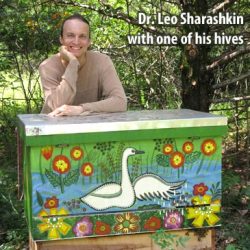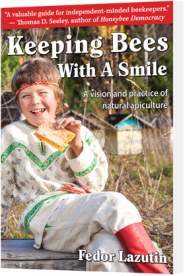I recently finished Fedor Lazutin’s book Keeping Bees With A Smile. It is a rather fascinating read about keeping bees naturally in the depths of Russia, where the winters really are six months long. I have to thank the Happy Hour at the Top Bar blog for recommending the book. I really enjoyed the different perspective on beekeeping and discussion of a hive style I was not at all familiar with.
The Book
Lazutin repeatedly emphasizes that beekeeping is local. He advocates keeping local bees and not importing bees from outside your area. This ensures that you have bees that adapt to your region of the world, something he says is critical to keeping bees naturally. By naturally, Lazutin means treatment-free, and he does not have nice things to say about the industrialization of beekeeping under the Soviet regime.
The book is packed full of Lazutin’s opinions and experience. The chapters are pretty short and it was an enjoyable read. Some specific points I took away from the book:
- While bees prefer a spherical cluster, they will adapt to whatever shape hive they are in. Lautzin prefers a single long comb so the bees can work a single frame and the beekeeper doesn’t need to manage boxes. He says bees prefer a 10 inch cluster and will move 1 mm per day over the course of the winter. For his region, this translate to about 18 inches (45 cm) of comb. So he builds his hives to take a long double-deep frame of about 20 inches. An easy way to build this is to attached two deeps frames to each other.
- Lazutin inspects his hives twice a year: once in the spring to make sure they are ready for the nectar flow, and once in the fall to make sure they are ready for winter. He will also add frames (without inspecting) to keep the bees busy, and fills the box with comb when the flow hits.
- A nice section on wintering behavior gathers much of the current research (as of 2009) on how bees overwinter. He builds his hives to simulate the natural tree hollow bees prefer in old growth forests, which he says have 4-5 inch sides, an entire tree on top, and dead and decaying wood and leaves in the bottom. Thus his hives have well-insulated walls, better insulated roofs, and a mulch area beneath a screen on the bottom. They accommodate 17 by 20 inch frames. In the winter he reduces the hive down to 9 or 10 frames and places an insulated division board at the end to create a smaller space for the bees to keep warm.
- Did I say he’s a big fan of local bees? The native bee to Russia is the European Black Bee, similar to the German Black Bee originally brought to the United States. These bees are bigger than other races which helps them live longer during cold winters, and they can successfully store more waste before requiring a cleansing flight outside the hive. The temperatures in Lazutin’s region requires a cluster for 5-6 months each winter, much colder and longer than most places in the United States.
- Queen quality plays an important part of Lazutin’s thinking. He says that the practice of giving nucs open brood does not produce good quality queens, a recent research finding that Dr. David Tarpy talked about at the VSBA meeting. This is why he prefers bees to swarm, as this produces the best queens (also supported by recent research). He encourages his best hives to swarm by not expanding the nest in the spring.
- In Lazutin’s division boards, he leaves a bee space (3/8 in) below the board in the spring and summer so the bees know that the hive is bigger than their current set of frames. The bees will hang out in this open space and in some cases will start building comb if they have need of extra storage.
Some Thoughts
It should be noted that Russian bees have been dealing with varroa much longer than the rest of the world, and this could account for some of Lazutin’s success with no treatment or feeding. He points out a number of times that imported stock (Italians and other races) will dilute the gene pool and make it less likely for bees to survive a Russian winter. A number of western beekeepers have adopted this idea of letting bees manage their survival naturally, without treatments, from Phil Chandler to Wyatt Mangum to Michael Bush.
By the book’s logic, based on our Virginia winters of 3-4 months, we need roughly 15 inches of comb for winter (10 + 1 x 3.5 x 30 / 25). This matches well with the one deep (9 inches) and one medium (6 inches) recommendation for wintering bees in our area. I like the idea that the bees know what they are doing, and we should allow them to arrange the hive for winter however they wish rather than moving boxes and frames around to “help” them.
Lazutin also makes some strong points for insulation, which prompted me to insulate the tops of my hives in an attempt to keep condensation off the inner cover of the hive. I wonder if a fully insulated hive would help with the heat of summer as well as the relatively mild cold around here. Might be worth experimenting with sometime.
The idea of leaving a space under a top bar follower board is an interesting one, as I’ve heard that if you leave the inner board in the hive too long the bees will refuse to expand past where the board was located. This might be a way to avoid such a problem.
I have no plans to try one of these tall hives right now, though I am thinking about trying to build a top bar hive with a larger comb area. Lazutin as well as some local keepers say that the queen enjoys laying on larger comb. My current top bar combs are about the size of a medium frame (87 square inches), and with some wider boards I could build one to accommodate comb closer to a deep frame size (136 sq in). Not quite the double-deep size that Lazutin advocates, but it would be bigger. I’m working on a design and will have to share it at some point.
 Our title is taken directly from the title of the book Keeping Bees With A Smile, of course. Fedor Lazutin wrote the book in Russian in 2009, and it was translated to English in 2013 by Mark Pettus, Ph.D. and edited by Leonid Sharashkin, Ph.D. Dr. Sharashkin promotes the book via his web site horizontalhive.com and also teaches a class using the larger hives about keeping bees naturally.
Our title is taken directly from the title of the book Keeping Bees With A Smile, of course. Fedor Lazutin wrote the book in Russian in 2009, and it was translated to English in 2013 by Mark Pettus, Ph.D. and edited by Leonid Sharashkin, Ph.D. Dr. Sharashkin promotes the book via his web site horizontalhive.com and also teaches a class using the larger hives about keeping bees naturally.
Lazutin started the Medvinka Centre for natural beekeeping and eco-agriculture in the Kaluga region of Russia (near the town of Adamovka, see map). Lazutin says the centre “includes a model sustainable apiary, a European dark bee conservancy, and a nascent ecovillage — all in a place of amazing natural beauty.” That would be a pretty cool vacation sometime….
Unfortunately Lazutin passed away in February 2015 from complications related to brain cancer. Medvinka appears to live on, with the Russian page more up to date than the English version (if you are using Chrome, Google will translate the Russian for you).
The Horizontal Hive site includes plans for the large frames and hives if you are so inclined, or they will sell you a hive directly. I seem busy enough with the Langstroth and top bar hives for now, but if anyone tries this out please let me know as would love to hear about it firsthand.

Great review! So glad you liked the book! If I’m truly honest, I think the book could be organized better, but overall, it has great info. Each time I’ve read it, I’ve picked up something new.
Regarding the space under the follower, I’ve been doing that ever since I started keeping bees — before ever hearing about Lazutin or reading his book. For me, it was a practical decision because I wanted to feed in the hive without disturbing the bees. Hence, the gap in the follower board that allowed the bees to travel. Frequently, there are lots of bees behind the follower even when there’s no syrup. I don’t know what they’re doing in that space, but it sure does interest them. Once, I even spotted a noticed a softball-sized cluster of bees and a second queen behind the follower!
LikeLiked by 1 person
On the organization, it looks like the material is freely available in Russian online. So I think Lazutin wrote these as a series of articles. It explains the different sections and why there is some overlap.
On the follower board, I’ll have to give this a try. Makes perfect sense.
Thanks for the comment.
LikeLike
We initially put insulated ekes on our hives for the winter but then, reasoning that we do not remove attic insulation in our house for the summer, now leave them on year round. We have observed much less bearding (nearly none) in hot weather.
LikeLike
I’ve wondered about insulation in the summer. Seems reasonable that it would help year round. Given Virginia is more know for warm summers than cold winters, perhaps this would be a good approach around here.
LikeLike
Thanks for this book review – I second Lazutin’s view on keeping local bees. Emily and I have kept local bees with homemade queens for 7 years and I think they are better suited to local climate and conditions.
LikeLike
That’s my plan as well, we’ll see if it works. Two of my three queens started from locally-bred queens, hoping they pull through this ultra-warm winter we are having.
LikeLiked by 1 person
Hopefully they will. The past few years here have been on/off cold and mild winters. The bees seem to have learned to cope and just get on with it, while Emily and I have observed the hives with new imported queens don’t always do as well. It’s a shame the weather isn’t colder though, even beekeepers need a holiday.
LikeLiked by 1 person